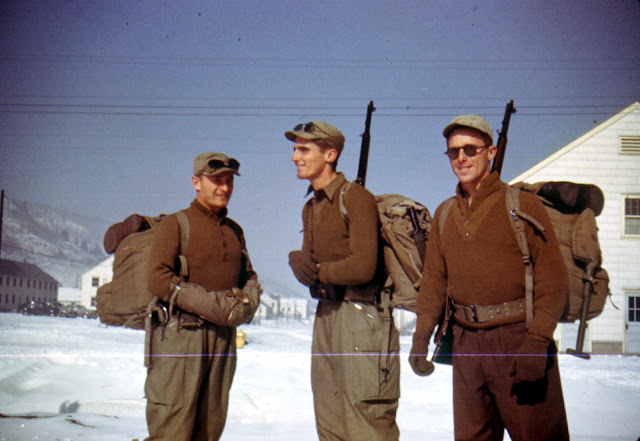Three unidentified Tenth Mountain Division soldiers pose for a photograph at Camp Hale, Colorado, 1943 or 1944. They are dressed for winter training. All are wearing caps, sunglasses, sweaters, and wool pants. All have M1943 mountain rucksack and are carrying Garand rifles. Snow covers the ground.
A mountain soldier could not fit all of his gear into the M-1928 haversack, the Army’s standard backpack at the beginning of World War II. Even if he could, the haversack carried the weight high on his back and it shifted side to side, throwing him off balance while skiing or climbing. Thus, the Army needed something more practical for their new mountain soldiers. In 1941, the Wood Yukon Expedition investigated several types of rucksacks and packframes for their potential for Army use. They recommended that a rucksack "capable of carrying all of the mountain and ski trooper's equipment should be developed." The rucksack, for use of mountain and arctic troops, was based on the Norse Pack. Various designs were tried and refined based on feedback from the tests. Jeffersonvile Quartermaster Depot continued to refine the rucksack's features, eventually leading to Tentative Specification J.Q.D. 88B (26 August 1942), a superior design produced in large quantity during World War II. The J.Q.D. 88B pattern Rucksack was used up to and including in Vietnam.
The Mountain Rucksack consisted of essentially a canvas sack, closed at the top by a drawstring, with a covering flap and pockets at the back and sides. It had web shoulder straps and a web belly strap. There was a detachable tubular steel frame at the front, which took much of the weight of the loaded rucksack off the shoulders, and placed it just above the hips. The frame also served to hold the loaded frame somewhat away from the back so that the pack was ventilated and excessive sweating did not take place. The lower frame curved around the back, projecting forward in the lower part of the frame, curved toward the front of the body just above the hips and kept the rucksack, with its load, from swinging sideways and destroying balance during rapid movements. Two of the frames, when detached from their sacks, could be attached to skis to form an emergency sled.
The main load of the mountain soldier, including cooking equipment, rations, sleeping bag, tent and extra clothing, was stowed inside the rucksack. Maps and other articles which might be needed during the march were placed in the outside pockets or a flat pocket in the cover flap. There were attachments for the bayonet or machete, the rifle and the intrenching tool. The rifle attachment was a snap link, added to the original design, that clipped to the butt sling swivel. The rifle was carried over the right shoulder alongside the rucksack, where it could be reached and unsnapped quickly for use. Meanwhile, the rifle was kept out of the way of the soldier who needed his hands for ski poles or for climbing. A white cover was issued with the rucksack for camouflage use in snowy country.
The main load of the mountain soldier, including cooking equipment, rations, sleeping bag, tent and extra clothing, was stowed inside the rucksack. Maps and other articles which might be needed during the march were placed in the outside pockets or a flat pocket in the cover flap. There were attachments for the bayonet or machete, the rifle and the intrenching tool. The rifle attachment was a snap link, added to the original design, that clipped to the butt sling swivel. The rifle was carried over the right shoulder alongside the rucksack, where it could be reached and unsnapped quickly for use. Meanwhile, the rifle was kept out of the way of the soldier who needed his hands for ski poles or for climbing. A white cover was issued with the rucksack for camouflage use in snowy country.
Source :
http://amyatishkin.livejournal.com/287245.html
http://www.mountaintroops.us/history_rucksack.html
http://olive-drab.com/od_soldiers_gear_mountain_rucksack.php













































